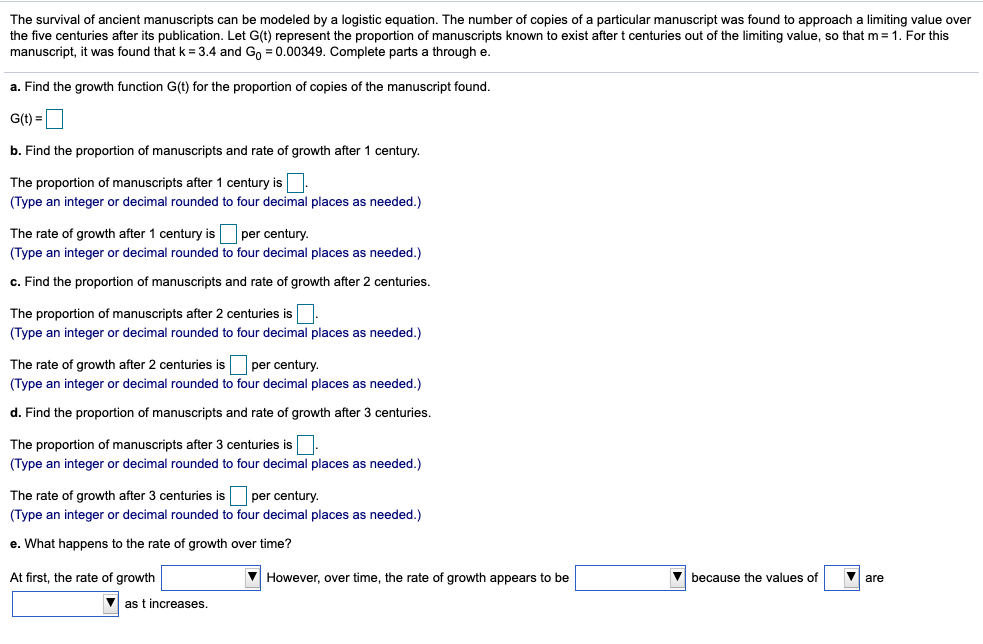

The survival of ancient manuscripts can be modeled by a logistic equation. The number of copies of a particular manuscript was found to approach a limiting value over the five centuries after its publication. Let G(t) represent the proportion of manuscripts known to exist after t centuries out of the limiting value, so that m1. For this manuscript, it was found that k-3.4 and Go0.00349. Complete parts a through e a. Find the growth function G(t) for the proportion of copies of the manuscript found G(t)- b. Find the proportion of manuscripts and rate of growth after 1 century. The proportion of manuscripts after 1 century is (Type an integer or decimal rounded to four decimal places as needed.) The rate of growth after 1 century isper century (Type an integer or decimal rounded to four decimal places as needed.) c. Find the proportion of manuscripts and rate of growth after 2 centuries The proportion of manuscripts after 2 centuries is (Type an integer or decimal rounded to four decimal places as needed.) The rate of growth after 2 centuries isper century. (Type an integer or decimal rounded to four decimal places as needed.) d. Find the proportion of manuscripts and rate of growth after 3 centuries. The proportion of manuscripts after 3 centuries is (Type an integer or decimal rounded to four decimal places as needed.) The rate of growth after 3 centuries is per century (Type an integer or decimal rounded to four decimal places as needed.) e. What happens to the rate of growth over time? At first, the rate of growth VHowever, over time, the rate of growth appears to be because the values ofare as t increases. this maruscript, twas found that -3.4 and G000349. Complete parts a through e a. Fnd the growth function Glti for the prepartion o copies ot the manucriptfound b. Find properton af manuscripts and rate af growth ater 1 camury. The propartion of manuscrips afer 1 canlury is Type an integer or decimal rounded to four decimal places as needed The rate of growth ater 1 centurys per century Type an intager or decimal rounded to four decimal places as noeded. G. Find the propartion of manuscripts and rale of growth after 2 centuries. The proportion of manuscripts after 2 centuries is Type an intager or decimal rounded to four decimal places as noeded. Type an iteger or decimal rounded to four decim places as needed d. Find tho propordion of manuscnipts and rate of growth ater 3 centurics Tha prepartion of manuscripts ati" 3 canturika isa Type an iteger or decimal rounded to four deciml places as needed The rate of growth ater 3 centuries iper century Type an integer or decimal rounded to four decimal places as nceded. .What happens lo the rale of growth aver 5me? Airst, the rate of growth However, aver tme, the rate of growth appears to be because the valuesof are The survival of ancient manuscripts can be modeled by a logistic equation. The number of copies of a particular manuscript was found to approach a limiting value over the five centuries after its publication. Let G(t) represent the proportion of manuscripts known to exist after t centuries out of the limiting value, so that m1. For this manuscript, it was found that k-3.4 and Go0.00349. Complete parts a through e a. Find the growth function G(t) for the proportion of copies of the manuscript found G(t)- b. Find the proportion of manuscripts and rate of growth after 1 century. The proportion of manuscripts after 1 century is (Type an integer or decimal rounded to four decimal places as needed.) The rate of growth after 1 century isper century (Type an integer or decimal rounded to four decimal places as needed.) c. Find the proportion of manuscripts and rate of growth after 2 centuries The proportion of manuscripts after 2 centuries is (Type an integer or decimal rounded to four decimal places as needed.) The rate of growth after 2 centuries isper century. (Type an integer or decimal rounded to four decimal places as needed.) d. Find the proportion of manuscripts and rate of growth after 3 centuries. The proportion of manuscripts after 3 centuries is (Type an integer or decimal rounded to four decimal places as needed.) The rate of growth after 3 centuries is per century (Type an integer or decimal rounded to four decimal places as needed.) e. What happens to the rate of growth over time? At first, the rate of growth VHowever, over time, the rate of growth appears to be because the values ofare as t increases. this maruscript, twas found that -3.4 and G000349. Complete parts a through e a. Fnd the growth function Glti for the prepartion o copies ot the manucriptfound b. Find properton af manuscripts and rate af growth ater 1 camury. The propartion of manuscrips afer 1 canlury is Type an integer or decimal rounded to four decimal places as needed The rate of growth ater 1 centurys per century Type an intager or decimal rounded to four decimal places as noeded. G. Find the propartion of manuscripts and rale of growth after 2 centuries. The proportion of manuscripts after 2 centuries is Type an intager or decimal rounded to four decimal places as noeded. Type an iteger or decimal rounded to four decim places as needed d. Find tho propordion of manuscnipts and rate of growth ater 3 centurics Tha prepartion of manuscripts ati" 3 canturika isa Type an iteger or decimal rounded to four deciml places as needed The rate of growth ater 3 centuries iper century Type an integer or decimal rounded to four decimal places as nceded. .What happens lo the rale of growth aver 5me? Airst, the rate of growth However, aver tme, the rate of growth appears to be because the valuesof are








